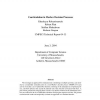Free Online Productivity Tools
i2Speak
i2Symbol
i2OCR
iTex2Img
iWeb2Print
iWeb2Shot
i2Type
iPdf2Split
iPdf2Merge
i2Bopomofo
i2Arabic
i2Style
i2Image
i2PDF
iLatex2Rtf
Sci2ools
NIPS
2004
2004
Coarticulation in Markov Decision Processes
We investigate an approach for simultaneously committing to multiple activities, each modeled as a temporally extended action in a semi-Markov decision process (SMDP). For each activity we define a set of admissible solutions consisting of the redundant set of optimal policies, and those policies that ascend the optimal state-value function associated with them. A plan is then generated by merging them in such a way that the solutions to the subordinate activities are realized in the set of admissible solutions satisfying the superior activities. We present our theoretical results and empirically evaluate our approach in a simulated domain.
Admissible Solutions | NIPS 2004 | NIPS 2007 | Optimal State-value Function | Semi-Markov Decision Process |
| Added | 31 Oct 2010 |
| Updated | 31 Oct 2010 |
| Type | Conference |
| Year | 2004 |
| Where | NIPS |
| Authors | Khashayar Rohanimanesh, Robert Platt Jr., Sridhar Mahadevan, Roderic A. Grupen |
Comments (0)

